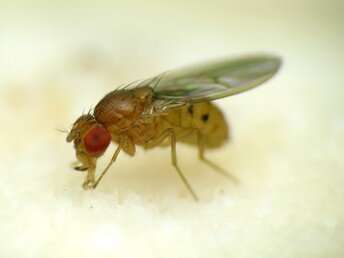How fruit flies flock together in orderly clusters

Opposing desires to congregate and maintain some personal space drive fruit flies to form orderly clusters, according to a study published today in eLife.
Many animals ranging from swarming insects to wildebeests form large, orderly groups. This collective behaviour is often crucial to survival. It may help animals find food, escape predators, enhance the way they sense their surroundings and augment their decision making. But the processes that enable these group gatherings are not well understood.
It can be difficult to study large animal groups in the wild, but studying smaller animals in the laboratory can help scientists tease apart the processes that drive animal clustering step by step. For this work, researchers in China looked at what drives clustering in the sociable fruit fly Drosophila melanogaster.
"Analysing the aggregation process in fruit flies would help us understand how individuals interact to form a social group and what senses are used during this process," says lead author Lifen Jiang, a Ph.D. student at the School of Life Sciences, University of Science and Technology of China, Hefei. "Looking at this process in fruit flies may give us some insight into more complex collective behaviours in other animals."
In their experiments, Jiang and the team discovered that fruit flies placed in shallow, covered dishes spontaneously form clusters with regular spacing between flies. By observing the flies, the scientists learned that these formations are driven by fly-fly interactions in which the flies use their legs and wings to touch each other and then establish some personal space. But when the team systematically interfered with their senses, including sight, odour and touch, this stopped the flies from forming these neat clusters. "Depriving fruit flies of their senses resulted in abnormal responses to encountering another fly and a high failure rate of cluster formation," Jiang explains.
The researchers then showed that the flies' physical interactions with each other switch on their sensory nerve cells. Without these cells, they are unable to establish the usual socially acceptable distances between themselves and other flies that are necessary to form organised clusters.
"Our findings suggest that self-organisation in flies might rely on just a few simple rules," says senior author Yan Zhu, Ph.D., Professor at the Institute of Biophysics, Chinese Academy of Sciences, Beijing. "More studies are now needed to determine whether similar rules govern gatherings in larger animals."
More information: Lifen Jiang et al, Emergence of social cluster by collective pairwise encounters in Drosophila, eLife (2020). DOI: 10.7554/eLife.51921
Journal information: eLife
Provided by eLife




















